Enyu Shi
Sherman
Energy-Efficient SIM-assisted Communications: How Many Layers Do We Need?
Apr 22, 2025Abstract:The stacked intelligent metasurface (SIM), comprising multiple layers of reconfigurable transmissive metasurfaces, is becoming an increasingly viable solution for future wireless communication systems. In this paper, we explore the integration of SIM in a multi-antenna base station for application to downlink multi-user communications, and a realistic power consumption model for SIM-assisted systems is presented. Specifically, we focus on maximizing the energy efficiency (EE) for hybrid precoding design, i.e., the base station digital precoding and SIM wave-based beamforming. Due to the non-convexity and high complexity of the formulated problem, we employ the quadratic transformation method to reformulate the optimization problem and propose an alternating optimization (AO)-based joint precoding framework. Specifically, a successive convex approximation (SCA) algorithm is adopted for the base station precoding design. For the SIM wave-based beamforming, two algorithms are employed: the high-performance semidefinite programming (SDP) method and the low-complexity projected gradient ascent (PGA) algorithm. In particular, the results indicate that while the optimal number of SIM layers for maximizing the EE and spectral efficiency differs, a design of 2 to 5 layers can achieve satisfactory performance for both. Finally, numerical results are illustrated to evaluate the effectiveness of the proposed hybrid precoding framework and to showcase the performance enhancement achieved by the algorithm in comparison to benchmark schemes.
Joint Power Allocation and Phase Shift Design for Stacked Intelligent Metasurfaces-aided Cell-Free Massive MIMO Systems with MARL
Feb 27, 2025



Abstract:Cell-free (CF) massive multiple-input multiple-output (mMIMO) systems offer high spectral efficiency (SE) through multiple distributed access points (APs). However, the large number of antennas increases power consumption. We propose incorporating stacked intelligent metasurfaces (SIM) into CF mMIMO systems as a cost-effective, energy-efficient solution. This paper focuses on optimizing the joint power allocation of APs and the phase shift of SIMs to maximize the sum SE. To address this complex problem, we introduce a fully distributed multi-agent reinforcement learning (MARL) algorithm. Our novel algorithm, the noisy value method with a recurrent policy in multi-agent policy optimization (NVR-MAPPO), enhances performance by encouraging diverse exploration under centralized training and decentralized execution. Simulations demonstrate that NVR-MAPPO significantly improves sum SE and robustness across various scenarios.
Energy-Efficient RIS-Aided Cell-Free Massive MIMO Systems: Application, Opportunities, and Challenges
Dec 23, 2024



Abstract:Reconfigurable intelligent surfaces (RIS)-assisted cell-free massive multiple-input multiple-output (CF mMIMO) systems have emerged as a promising technology for sixth-generation communication systems. These systems capitalize on RIS to minimize power consumption, thereby achieving consistent performance and enhancing communication quality through the establishment and shaping of auxiliary signal propagation pathways between access points (APs) and users. However, integrating RIS into existing CF mMIMO infrastructures presents several technical challenges. This study delves into the signal transmission scheme and deployment architecture of RIS-aided CF mMIMO systems, addressing inherent challenges such as interference induced by RIS and the increased complexity in beam alignment. Furthermore, we address the complexities arising from the joint optimization of the reflection phase of RIS and beamforming technology at the APs, intending to fully exploit the reflection capabilities of RISs and beamforming technology to maximize the energy efficiency (EE) of the system. To overcome these challenges, we propose cooperation communication to suppress RIS-induced interference, beam tracking, and joint optimization to improve system EE. We also present specific examples of cooperative communication under the constraint of electromagnetic interference and the beam tracking of a mobile system. Additionally, we emphasize important research directions for RIS-aided CF mMIMO systems, aiming to inspire future investigations.
Mobile Cell-Free Massive MIMO with Multi-Agent Reinforcement Learning: A Scalable Framework
Dec 03, 2024



Abstract:Cell-free massive multiple-input multiple-output (mMIMO) offers significant advantages in mobility scenarios, mainly due to the elimination of cell boundaries and strong macro diversity. In this paper, we examine the downlink performance of cell-free mMIMO systems equipped with mobile-APs utilizing the concept of unmanned aerial vehicles, where mobility and power control are jointly considered to effectively enhance coverage and suppress interference. However, the high computational complexity, poor collaboration, limited scalability, and uneven reward distribution of conventional optimization schemes lead to serious performance degradation and instability. These factors complicate the provision of consistent and high-quality service across all user equipments in downlink cell-free mMIMO systems. Consequently, we propose a novel scalable framework enhanced by multi-agent reinforcement learning (MARL) to tackle these challenges. The established framework incorporates a graph neural network (GNN)-aided communication mechanism to facilitate effective collaboration among agents, a permutation architecture to improve scalability, and a directional decoupling architecture to accurately distinguish contributions. In the numerical results, we present comparisons of different optimization schemes and network architectures, which reveal that the proposed scheme can effectively enhance system performance compared to conventional schemes due to the adoption of advanced technologies. In particular, appropriately compressing the observation space of agents is beneficial for achieving a better balance between performance and convergence.
Joint Precoding and AP Selection for Energy Efficient RIS-aided Cell-Free Massive MIMO Using Multi-agent Reinforcement Learning
Nov 17, 2024
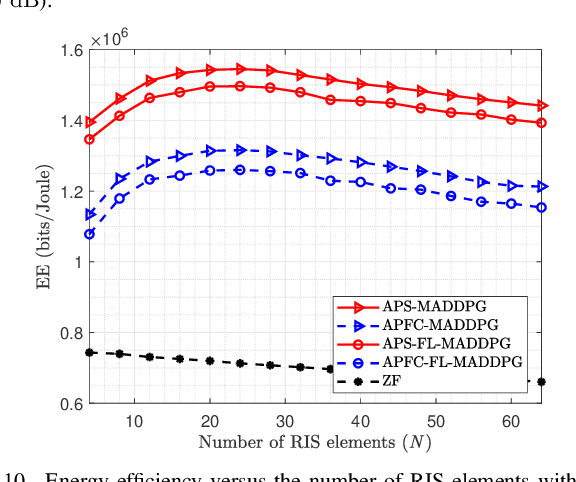
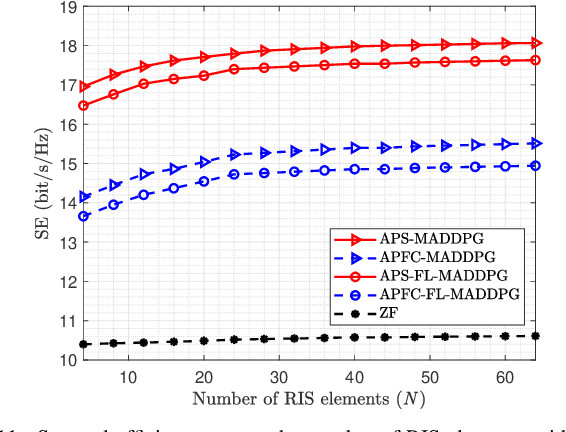

Abstract:Cell-free (CF) massive multiple-input multiple-output (mMIMO) and reconfigurable intelligent surface (RIS) are two advanced transceiver technologies for realizing future sixth-generation (6G) networks. In this paper, we investigate the joint precoding and access point (AP) selection for energy efficient RIS-aided CF mMIMO system. To address the associated computational complexity and communication power consumption, we advocate for user-centric dynamic networks in which each user is served by a subset of APs rather than by all of them. Based on the user-centric network, we formulate a joint precoding and AP selection problem to maximize the energy efficiency (EE) of the considered system. To solve this complex nonconvex problem, we propose an innovative double-layer multi-agent reinforcement learning (MARL)-based scheme. Moreover, we propose an adaptive power threshold-based AP selection scheme to further enhance the EE of the considered system. To reduce the computational complexity of the RIS-aided CF mMIMO system, we introduce a fuzzy logic (FL) strategy into the MARL scheme to accelerate convergence. The simulation results show that the proposed FL-based MARL cooperative architecture effectively improves EE performance, offering a 85\% enhancement over the zero-forcing (ZF) method, and achieves faster convergence speed compared with MARL. It is important to note that increasing the transmission power of the APs or the number of RIS elements can effectively enhance the spectral efficiency (SE) performance, which also leads to an increase in power consumption, resulting in a non-trivial trade-off between the quality of service and EE performance.
Cooperative Multi-Target Positioning for Cell-Free Massive MIMO with Multi-Agent Reinforcement Learning
Oct 09, 2024



Abstract:Cell-free massive multiple-input multiple-output (mMIMO) is a promising technology to empower next-generation mobile communication networks. In this paper, to address the computational complexity associated with conventional fingerprint positioning, we consider a novel cooperative positioning architecture that involves certain relevant access points (APs) to establish positioning similarity coefficients. Then, we propose an innovative joint positioning and correction framework employing multi-agent reinforcement learning (MARL) to tackle the challenges of high-dimensional sophisticated signal processing, which mainly leverages on the received signal strength information for preliminary positioning, supplemented by the angle of arrival information to refine the initial position estimation. Moreover, to mitigate the bias effects originating from remote APs, we design a cooperative weighted K-nearest neighbor (Co-WKNN)-based estimation scheme to select APs with a high correlation to participate in user positioning. In the numerical results, we present comparisons of various user positioning schemes, which reveal that the proposed MARL-based positioning scheme with Co-WKNN can effectively improve positioning performance. It is important to note that the cooperative positioning architecture is a critical element in striking a balance between positioning performance and computational complexity.
Distributed Collaborative User Positioning for Cell-Free Massive MIMO with Multi-Agent Reinforcement Learning
Oct 07, 2024



Abstract:In this paper, we investigate a cell-free massive multiple-input multiple-output system, which exhibits great potential in enhancing the capabilities of next-generation mobile communication networks. We first study the distributed positioning problem to lay the groundwork for solving resource allocation and interference management issues. Instead of relying on computationally and spatially complex fingerprint positioning methods, we propose a novel two-stage distributed collaborative positioning architecture with multi-agent reinforcement learning (MARL) network, consisting of a received signal strength-based preliminary positioning network and an angle of arrival-based auxiliary correction network. Our experimental results demonstrate that the two-stage distributed collaborative user positioning architecture can outperform conventional fingerprint positioning methods in terms of positioning accuracy.
Joint SIM Configuration and Power Allocation for Stacked Intelligent Metasurface-assisted MU-MISO Systems with TD3
Aug 11, 2024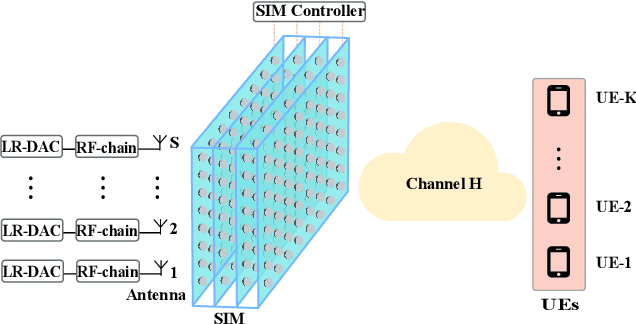
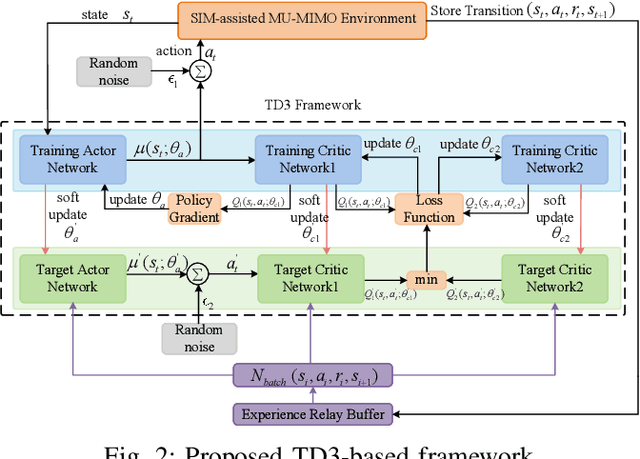
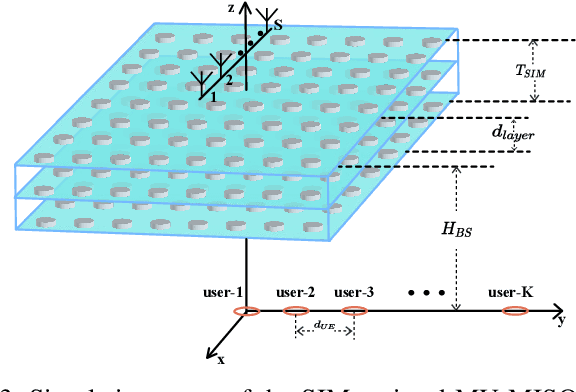
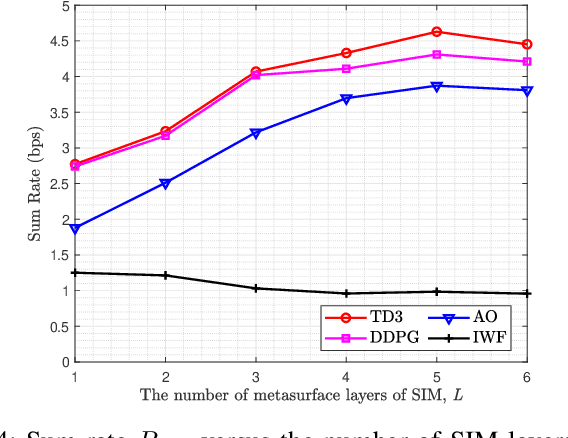
Abstract:The stacked intelligent metasurface (SIM) emerges as an innovative technology with the ability to directly manipulate electromagnetic (EM) wave signals, drawing parallels to the operational principles of artificial neural networks (ANN). Leveraging its structure for direct EM signal processing alongside its low-power consumption, SIM holds promise for enhancing system performance within wireless communication systems. In this paper, we focus on SIM-assisted multi-user multi-input and single-output (MU-MISO) system downlink scenarios in the transmitter. We proposed a joint optimization method for SIM phase shift configuration and antenna power allocation based on the twin delayed deep deterministic policy gradient (TD3) algorithm to efficiently improve the sum rate. The results show that the proposed algorithm outperforms both deep deterministic policy gradient (DDPG) and alternating optimization (AO) algorithms. Furthermore, increasing the number of meta-atoms per layer of the SIM is always beneficial. However, continuously increasing the number of layers of SIM does not lead to sustained performance improvement.
RIS-Aided Cell-Free Massive MIMO Systems for 6G: Fundamentals, System Design, and Applications
Sep 30, 2023



Abstract:An introduction of intelligent interconnectivity for people and things has posed higher demands and more challenges for sixth-generation (6G) networks, such as high spectral efficiency and energy efficiency, ultra-low latency, and ultra-high reliability. Cell-free (CF) massive multiple-input multiple-output (mMIMO) and reconfigurable intelligent surface (RIS), also called intelligent reflecting surface (IRS), are two promising technologies for coping with these unprecedented demands. Given their distinct capabilities, integrating the two technologies to further enhance wireless network performances has received great research and development attention. In this paper, we provide a comprehensive survey of research on RIS-aided CF mMIMO wireless communication systems. We first introduce system models focusing on system architecture and application scenarios, channel models, and communication protocols. Subsequently, we summarize the relevant studies on system operation and resource allocation, providing in-depth analyses and discussions. Following this, we present practical challenges faced by RIS-aided CF mMIMO systems, particularly those introduced by RIS, such as hardware impairments and electromagnetic interference. We summarize corresponding analyses and solutions to further facilitate the implementation of RIS-aided CF mMIMO systems. Furthermore, we explore an interplay between RIS-aided CF mMIMO and other emerging 6G technologies, such as next-generation multiple-access (NGMA), simultaneous wireless information and power transfer (SWIPT), and millimeter wave (mmWave). Finally, we outline several research directions for future RIS-aided CF mMIMO systems.
Uplink Performance of RIS-aided Cell-Free Massive MIMO System with Electromagnetic Interference
Jun 14, 2023



Abstract:Cell-free (CF) massive multiple-input multiple-output (MIMO) and reconfigurable intelligent surface (RIS) are two promising technologies for realizing future beyond-fifth generation (B5G) networks. In this paper, we consider a practical spatially correlated RIS-aided CF massive MIMO system with multi-antenna access points (APs) over spatially correlated fading channels. Different from previous work, the electromagnetic interference (EMI) at RIS is considered to further characterize the system performance of the actual environment. Then, we derive the closed-form expression for the system spectral efficiency (SE) with the maximum ratio (MR) combining at the APs and the large-scale fading decoding (LSFD) at the central processing unit (CPU). Moreover, to counteract the near-far effect and EMI, we propose practical fractional power control (FPC) and max-min power control algorithms to further improve the system performance. We unveil the impact of EMI, channel correlations, and different signal processing methods on the uplink SE of user equipments (UEs). The accuracy of our derived analytical results is verified by extensive Monte-Carlo simulations. Our results show that the EMI can substantially degrade the SE, especially for those UEs with unsatisfactory channel conditions. Besides, increasing the number of RIS elements is always beneficial in terms of the SE, but with diminishing returns when the number of RIS elements is sufficiently large. Furthermore, the existence of spatial correlations among RIS elements can deteriorate the system performance when RIS is impaired by EMI.
 Add to Chrome
Add to Chrome Add to Firefox
Add to Firefox Add to Edge
Add to Edge